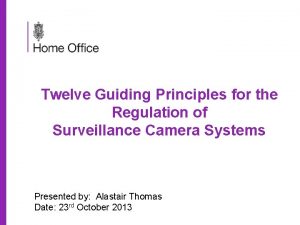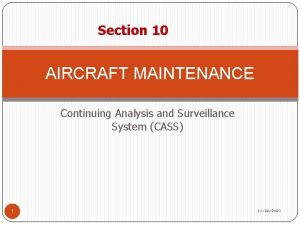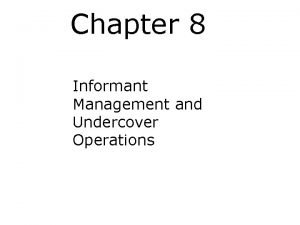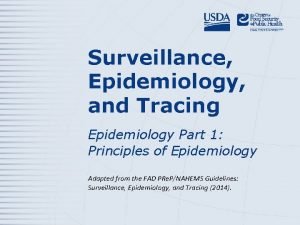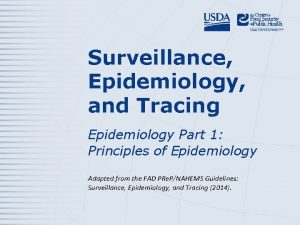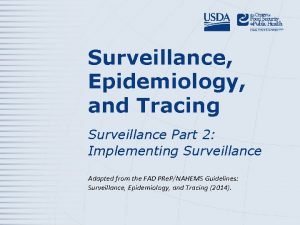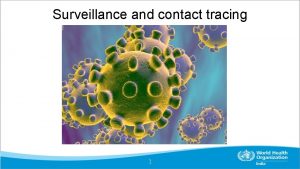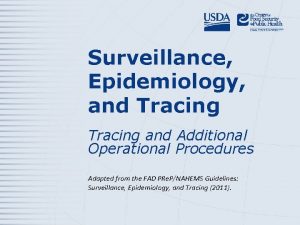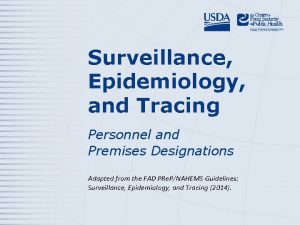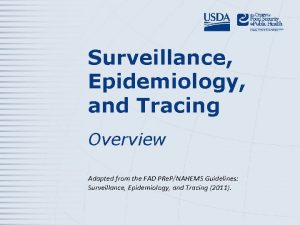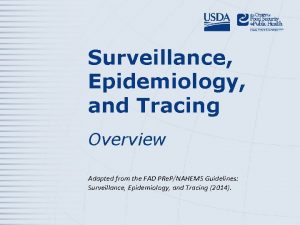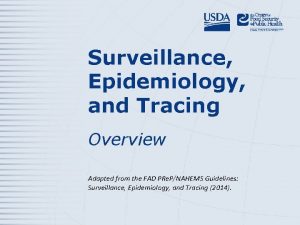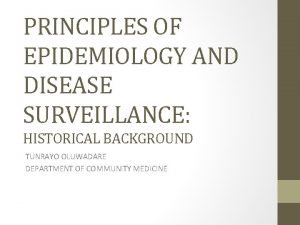Surveillance Epidemiology and Tracing Epidemiology Part 1 Principles
























- Slides: 24

Surveillance, Epidemiology, and Tracing Epidemiology Part 1: Principles of Epidemiology Adapted from the FAD PRe. P/NAHEMS Guidelines: Surveillance, Epidemiology, and Tracing (2011).

What is Epidemiology? • Study of disease in populations and factors that determine the occurrence of disease FAD PRe. P/NAHEMS Guidelines: Surveillance, Epi, and Tracing - Epidemiology Part 1 USDA APHIS and CFSPH

Functions of Epidemiology FAD PRe. P/NAHEMS Guidelines: Surveillance, Epi, and Tracing - Epidemiology Part 1 USDA APHIS and CFSPH

Core Functions • Surveillance – Ongoing data collection, analysis, interpretation, and dissemination – Used to determine specific actions for FAD mitigation • Field investigation – Used to collect additional information about cases identified via surveillance • Disease source, history of disease, etc. FAD PRe. P/NAHEMS Guidelines: Surveillance, Epi, and Tracing - Epidemiology Part 1 USDA APHIS and CFSPH

Core Functions (cont’d) • Analytic studies – Utilizes information gleaned from surveillance activities and field investigations – Disease rates and risk factors • Evaluation – Effectiveness – Efficacy – Impact of activities FAD PRe. P/NAHEMS Guidelines: Surveillance, Epi, and Tracing - Epidemiology Part 1 USDA APHIS and CFSPH

Disease Characteristics FAD PRe. P/NAHEMS Guidelines: Surveillance, Epi, and Tracing - Epidemiology Part 1 USDA APHIS and CFSPH

Natural History of Disease • Course of disease progression – Pathogen exposure – Subclinical illness – Onset of clinical signs – Recovery, disability, or death FAD PRe. P/NAHEMS Guidelines: Surveillance, Epi, and Tracing - Epidemiology Part 1 USDA APHIS and CFSPH

Transmission Modes • Many ways to transmit disease – Direct transmission – Indirect transmission • Zoonotic diseases – Diseases transmissible between animals and humans – May be transmitted directly or indirectly FAD PRe. P/NAHEMS Guidelines: Surveillance, Epi, and Tracing - Epidemiology Part 1 USDA APHIS and CFSPH

Disease Occurrence FAD PRe. P/NAHEMS Guidelines: Surveillance, Epi, and Tracing - Epidemiology Part 1 USDA APHIS and CFSPH

Levels of Disease • Endemic – Disease present in population or geographical area at all times • Outbreak – Occurrence of more cases of disease than expected • Given area/group, specific time period – May be used interchangeably with the term “epidemic” FAD PRe. P/NAHEMS Guidelines: Surveillance, Epi, and Tracing - Epidemiology Part 1 USDA APHIS and CFSPH

Levels of Disease (cont’d) • Pandemic – An outbreak/epidemic that has spread over several countries FAD PRe. P/NAHEMS Guidelines: Surveillance, Epi, and Tracing - Epidemiology Part 1 USDA APHIS and CFSPH

Causation • Environment – Husbandry, housing, climate/season, presence of vectors • Agent – Host range, environmental resistance, tissue affinity, dose, mode of transmission • Host – Species, breed, age, nutritional and immune status FAD PRe. P/NAHEMS Guidelines: Surveillance, Epi, and Tracing - Epidemiology Part 1 USDA APHIS and CFSPH

Risk Factors • A characteristic that is associated with an increase in the occurrence of a particular disease • May include: – Age – Species – Location – Contact FAD PRe. P/NAHEMS Guidelines: Surveillance, Epi, and Tracing - Epidemiology Part 1 USDA APHIS and CFSPH

Understanding Data and Measures of Disease FAD PRe. P/NAHEMS Guidelines: Surveillance, Epi, and Tracing - Epidemiology Part 1 USDA APHIS and CFSPH

Descriptive Statistics • Measures of central tendency – Mean, median, and mode • Range – Difference between largest and smallest value • Standard deviation – Spread around mean value of data set FAD PRe. P/NAHEMS Guidelines: Surveillance, Epi, and Tracing - Epidemiology Part 1 USDA APHIS and CFSPH

Confidence Interval • Represents range within which the true value lies • Calculated based on a percentage – 95% commonly used • 95% confidence interval – True value falls within the given range 95 percent of the time FAD PRe. P/NAHEMS Guidelines: Surveillance, Epi, and Tracing - Epidemiology Part 1 USDA APHIS and CFSPH

Measures of Disease • Prevalence – Total number of cases of a disease in a given population at a specific time • Incidence – Number of new cases of disease in a defined population over a specific time period FAD PRe. P/NAHEMS Guidelines: Surveillance, Epi, and Tracing - Epidemiology Part 1 USDA APHIS and CFSPH

Measures of Disease (cont’d) • Mortality rate – Number of deaths in a defined population during a specific time period • Case fatality rate – Percentage of animals diagnosed with a specific disease who die as a result of the disease within a specified period of time FAD PRe. P/NAHEMS Guidelines: Surveillance, Epi, and Tracing - Epidemiology Part 1 USDA APHIS and CFSPH

Measures of Association • Examines the differences in occurrence of disease in different segments of the population – Factors that might influence disease occurrence – Risk ratio and odds ratio FAD PRe. P/NAHEMS Guidelines: Surveillance, Epi, and Tracing - Epidemiology Part 1 USDA APHIS and CFSPH

Displaying Data • Tables, graphs, and charts – Visual means for comparing data – Demonstrate patterns, differences, and other relationships FAD PRe. P/NAHEMS Guidelines: Surveillance, Epi, and Tracing - Epidemiology Part 1 USDA APHIS and CFSPH

Displaying Data (cont’d) • Maps and GIS – Geographic location of disease – Levels and rates of disease FAD PRe. P/NAHEMS Guidelines: Surveillance, Epi, and Tracing - Epidemiology Part 1 USDA APHIS and CFSPH

For More Information • FAD PRe. P/NAHEMS Guidelines & SOP: Surveillance, Epidemiology, and Tracing (2011) – http: //www. aphis. usda. gov/animal_ health/emergency_management/ • Surveillance, Epidemiology, and Tracing web-based training module – http: //naherc. sws. iastate. edu/ FAD PRe. P/NAHEMS Guidelines: Surveillance, Epi, and Tracing - Epidemiology Part 1 USDA APHIS and CFSPH

Guidelines Content Authors (CFSPH) • Kerry Leedom Larson, DVM, MPH, Ph. D, DACVPM • Glenda Dvorak, DVM, MPH, DACVPM • Janice Mogan, DVM • Courtney Blake, BA Reviewers (USDA APHIS VS) • • Dr. Dr. R. Alex Thompson Lowell Andersen Steve Goff Fred Bourgeois FAD PRe. P/NAHEMS Guidelines: Surveillance, Epi, and Tracing - Epidemiology Part 1 USDA APHIS and CFSPH

Acknowledgments Development of this presentation was by the Center for Food Security and Public Health at Iowa State University through funding from the USDA APHIS Veterinary Services PPT Authors: Patricia Futoma, Veterinary Student; Kerry Leedom Larson, DVM, MPH, Ph. D, DACVPM Reviewer: Janice Mogan, DVM
 Principles of surveillance
Principles of surveillance Thesourceagents
Thesourceagents Nutrition epidemiology definition
Nutrition epidemiology definition Descriptive vs analytical epidemiology
Descriptive vs analytical epidemiology Incidence vs prevalence
Incidence vs prevalence Cbic recertification
Cbic recertification Epidemiology person place time
Epidemiology person place time Ray tracing and ray casting
Ray tracing and ray casting Staple core in fingerprint
Staple core in fingerprint Continuing analysis and surveillance system
Continuing analysis and surveillance system Prc-137 hf radio
Prc-137 hf radio Elements of undercover operation
Elements of undercover operation National institute for food and drug surveillance
National institute for food and drug surveillance Rumus odds ratio
Rumus odds ratio Logistic regression epidemiology
Logistic regression epidemiology Point and period prevalence
Point and period prevalence Descriptive vs analytical epidemiology
Descriptive vs analytical epidemiology Attack rate calculation
Attack rate calculation Bibliography of epidemiology
Bibliography of epidemiology Example of recall bias
Example of recall bias Attack rate calculation
Attack rate calculation Rambo critical appraisal tool
Rambo critical appraisal tool Wheel model of causation
Wheel model of causation Prevalence defination
Prevalence defination Defination of epidemiology
Defination of epidemiology
